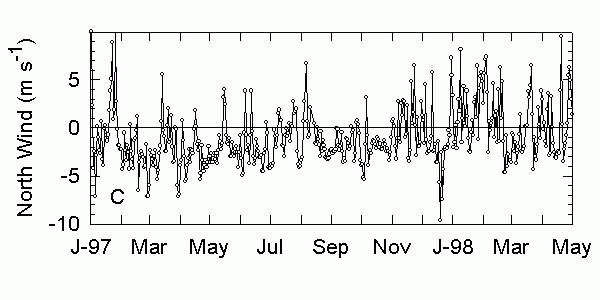
Upwelling
Upwelling of deep water occurs along the western margin of continents when the wind blows towards the equator. As the wind blows the water towards the equator, a Coriolis force causes the water to turn west and away from the coast. Water must rise up from depths of 60 to 200 m (it upwells) to replace the water that is moving away from the coast.
The water turns away from the coast as it moves south because the surface of the earth is rotating around the North Pole at greater speed as it moves towards the equator. The circumference of the surface, along a line of latitude, increases from 0 at the poles to about 40080 km at the equator. The rotational speed is 0 km/day at the pole and 40080 km/day to the east at the equator. The circumference is about 32430 km at 36º N and 32015 km at 37º N. If the ocean were completely at rest, then water at 37º N is rotating around the earth at 32015 km/day to the east. It the wind now blows that water due south to 36º N, it will tend to rotate at its original speed (ignoring friction), but the rest of the ocean and the continent at 36º N will be rotating at 32430 km/day, which is 415 km/day faster. The water going south will lag behind the continental margin and curve to the west. That's the Coriolis force and the reason water moving towards the equator on the West Coast causes upwelling. Along California the strongest southerly winds occur during spring. Winter storms cause the wind to reverse and blow north (see Figure).
What happens when the wind blows north?
What happens when the wind blows south along the east coast?

North component of the wind in Monterey Bay from Jan. 1997 to May 1998. Winds to the South have a negative velocity. A velocity of 1 meter/second is about 2 miles/hour.